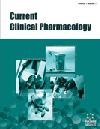- Home
- A-Z Publications
- Current Clinical Pharmacology
- Previous Issues
- Volume 4, Issue 1, 2009
Current Clinical Pharmacology - Volume 4, Issue 1, 2009
Volume 4, Issue 1, 2009
-
-
Rosuvastatin Induced Rhabdomyolysis in a Low Risk Patient: A Case Report and Review of the Literature
More LessAuthors: Fahmi Y. Khan and Wael IbrahimWe report a case of rosuvastatin induced rhabdomyolysis in a low risk patient, who presented with five-day history of generalized muscle pain, weakness and easy fatigability associated with passing dark urine. Initial investigations showed creatinine 140μmol/L, creatine kinase (CK) 4566 U/L and serum myoglobin 2694 ng/ml with a significant increase in urine myoglobin. Although there were no obvious risk factors, the patient Read More
-
-
-
State of the Art Clinical Efficacy and Safety Evaluation of N-Acetylcarnosine Dipeptide Ophthalmic Prodrug. Principles for the Delivery, Self-Bioactivation, Molecular Targets and Interaction with a Highly Evolved Histidyl-Hydrazide Structure in the Treatment and Therapeutic Management of a Group of Sight-Threatening Eye Diseases
More LessAuthors: Mark A. Babizhayev and Anne Kasus-JacobiFull text svailable
-
-
-
Evaluation of Human Plasma Protein Binding of Trabectedin (Yondelis™, ET-743)
More LessAuthors: Jan H. Beumer, L. Lopez-Lazaro, Jan H.M. Schellens, Jos H. Beijnen and Olaf van TellingenTrabectedin (ET-743, Yondelis™) is a novel anticancer drug with impressive activity in soft tissue sarcoma with a manageable, non-cumulative toxicity profile. Protein binding can be a major determinant of unbound concentration, volume of distribution, renal and hepatic clearance, and the half-life of a drug. Human plasma protein binding of trabectedin has not previously been reported. Using ultrafiltration techniques, we d Read More
-
-
-
Anti-Cancer Properties of Nigella spp. Essential Oils and their Major Constituents, Thymoquinone and β-Elemene
More LessBy Amr E. EdrisEssential oils are the volatile fraction of aromatic and medicinal plants after extraction by steam or water distillation. They have been used for their pharmaceutical potential since early times, and even now are still subject to a great deal of attention, as is clear from the increasing number of publications each year on this subject. This review presents both fundamental and recent studies concerned with the role of Nigella spec Read More
-
-
-
Novel Options for the Pharmacological Treatment of Chronic Anal Fissure - Role of Botulin Toxin
More LessAuthors: Mariusz Madalinski and Leszek KalinowskiA chronic anal fissure (CAF) is commonly referred to as an ischemic ulcer. For many years it was thought that sphincteroctomy produces anal sphincter relaxation, enhances microcirculation and promotes CAF healing. The latest studies have shown that fissure healing does not appear to be dependent on reduction in mean resting anal pressure. Our description of the process of CAF healing is based on understanding the Read More
-
-
-
Recent Advances in Obesity Pharmacotherapy
More LessAuthors: Marcos A. Mayer, Christian Hocht, Ana Puyo and Carlos A. TairaObesity is considered a worldwide epidemic. Weight reduction by means of lifestyle changes is difficult to achieve, and pharmacotherapy is frequently needed. Although all currently approved anti-obesity agents have proven to be effective to achieve some degree of weight reduction and improve cardiometabolic risk factors, different compounds differ in their mechanism of action and safety profile. However, it is still Read More
-
-
-
Evaluation of Efficacy and Safety of Fixed Dose Combination of Ceftazidime-Tobramycin in Comparison with Ceftazidime in Lower Respiratory Tract Infections
More LessAuthors: Manu Chaudhary, Sanjay M. Shrivastava and Rajesh SehgalLower respiratory tract infections are major cause of morbidity and mortality. Objectives were to evaluate efficacy and safety of fixed dose combination (FDC) of Ceftazidime and Tobramycin in comparison with Ceftazidime alone in patients with lower respiratory tract infections. Patients (n=240) were randomly distributed in two arms: one arm was treated with Ceftazidime(1g)-Tobramycin(120mg) and other arm was trea Read More
-
-
-
Structurally Modified ‘Dietary Flavonoids’: Are these Viable Drug Candidates for Chemoprevention?
More LessThe field of chemoprevention continues to be a heavily researched area since a few decades now. Whereas, the dietary intake of flavonoids occur via daily intakes of fruits, vegetables, herbal preparations, beverages etc, it appears that the active ingredients(s) contained in these dietary sources may not reach the required plasma and/or tissue concentrations in vivo to produce the desired pharmacological response expe Read More
-
-
-
Intensive Insulin Therapy in Critical Care Settings
More LessAuthors: Darla K. Eastman, Michelle M. Bottenberg, Karly A. Hegge, Heather Ourth and Udaya KabadiHyperglycemia in hospitalized patients has been shown to increase both morbidity and mortality, regardless of the presence of preexisting diabetes. In order to achieve recommended glycemic goals, many patients require the use of intravenous insulin therapy in the critical care setting. Following the publication of a landmark trial evaluating the benefits of intensive insulin therapy in critically ill patients, a worldwide increa Read More
-
-
-
Pharmacological Profile of SSRIs and SNRIs in the Treatment of Eating Disorders
More LessAuthors: Anna Capasso, Claudio Petrella and Walter MilanoBulimia Nervosa (BN) and Binge Eating Disorder (BED) are some of the most common eating disorders (ED) in industrialized societies, characterized by uncontrolled binge eating and self-induced purging or other compensatory behaviours aiming to prevent body weight gain. It has been suggested that reduced serotonergic and noradrenergig tone triggers some of the cognitive and mood disturbances associated with ED. Read More
-
Volumes & issues
Most Read This Month
Article
content/journals/ccp
Journal
10
5
false
en


